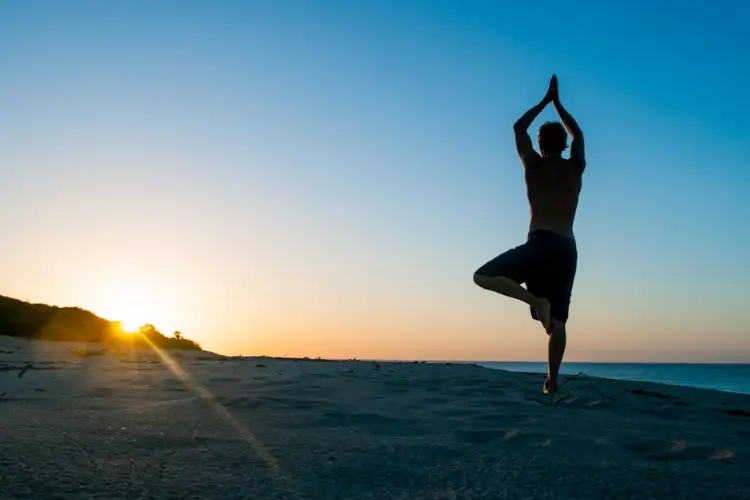Feeling that knot in your stomach when you’re separated from loved ones? Separation anxiety affects nearly 31.1% of adults at some point in their lives, making it one of the most common anxiety-related challenges people face.
Whether it’s dropping a child off at school, leaving for a business trip, or watching a loved one depart, that feeling of dread and worry can be overwhelming. Fortunately, ancient practices like yoga and meditation offer powerful tools for managing these emotions.
Let’s explore how these mind-body approaches can help you find calm and balance when separation anxiety strikes.
Understanding the Mind-Body Connection in Anxiety Management
When we experience anxiety, our bodies enter a state of heightened alertness, triggering a cascade of stress hormones that can leave us feeling tense, worried, and physically uncomfortable.
The Physiology of Separation Anxiety
When separation anxiety strikes, your body enters “fight or flight” mode. Your heart races, muscles tense, and breathing becomes shallow. These separation anxiety disorder treatments focus on calming this physiological response, helping you return to a state of balance. By addressing both psychological and physical symptoms, holistic approaches like yoga and meditation can be particularly effective.
How Yoga and Meditation Target Anxiety Symptoms
Both yoga and meditation work directly on the nervous system, helping regulate the body’s stress response. Mindfulness and separation anxiety reduction go hand-in-hand, as these practices teach us to observe our thoughts without judgment. This awareness creates space between triggering events and our reactions, allowing us to respond more calmly to separation situations.
Building Emotional Resilience Through Regular Practice
Consistent practice helps build neural pathways that support emotional regulation. Rather than eliminating anxiety, these practices help you develop a healthier relationship with anxious feelings, creating a foundation of inner security that remains stable even during separations.
The Science Behind Yoga and Meditation for Anxiety Relief
Research increasingly supports the effectiveness of both yoga and meditation as powerful tools for anxiety management. These practices create measurable changes in brain structure and function that directly impact how we process anxiety-producing situations.
Neurobiological Changes from Mindfulness Practices
Studies show that regular meditation changes the brain’s structure. The amygdala – your brain’s fear center – becomes less reactive with consistent practice. Meanwhile, meditation for anxiety strengthens the prefrontal cortex, the area responsible for rational thinking. This helps you maintain perspective when separation anxiety triggers arise.
Autonomic Nervous System Regulation Through Breathwork
One of yoga’s most powerful components is conscious breathing. When you’re experiencing separation anxiety, your breathing typically becomes shallow and rapid. Yoga for separation anxiety incorporates pranayama (breath control) techniques that activate the parasympathetic nervous system – your body’s “rest and digest” mode. This counteracts anxiety’s physical symptoms almost immediately.
Hormonal Balance and Stress Reduction
Both practices have been shown to reduce cortisol (the stress hormone) while increasing feel-good neurotransmitters like serotonin and GABA. This hormonal balancing act helps create a state of calm alertness, rather than anxious hypervigilance when facing separation situations.
Essential Yoga Poses for Separation Anxiety Management
When managing anxiety with yoga, certain poses are particularly effective for grounding, emotional processing, and restoration. These postures can be practiced individually or combined into a sequence for maximum benefit.
Grounding Poses to Create Security and Stability
When separation anxiety leaves you feeling unmoored, grounding poses help restore a sense of stability. Mountain Pose (Tadasana) creates a strong foundation through the feet, reminding you of your inner strength. Child’s Pose offers comfort similar to a self-hug, while Tree Pose builds confidence by improving balance, both physically and emotionally.
Heart-Opening Poses to Process Attachment Emotions
Separation anxiety often manifests as tightness in the chest area. Heart-opening poses like Cobra and Bridge help release this tension while facilitating emotional processing. These poses expand the chest, creating physical space that parallels the emotional space needed to handle separation with grace.
Restorative Poses for Nervous System Regulation
When anxiety has pushed your system into overdrive, restorative poses offer deep relief. Legs Up the Wall pose is particularly effective during acute anxiety episodes. Supported Bound Angle pose provides comfort to the nervous system, while a well-supported Corpse Pose teaches the valuable skill of conscious surrender.
Meditation Techniques Specifically Tailored for Separation Anxiety
Benefits of yoga and meditation for anxiety extend beyond physical postures. Specific meditation practices can directly address the thought patterns and emotional responses associated with separation fears.
Loving-Kindness Meditation (Metta) for Attachment Healing
Loving-kindness meditation directly addresses the attachment dimensions of separation anxiety. By directing well-wishes toward yourself and loved ones, you strengthen feelings of connection even when physically apart. This practice helps develop a sense of connection that transcends physical proximity.
Mindfulness Meditation for Present-Moment Awareness
Separation anxiety often pulls us into fearful future scenarios or painful past experiences. Mindfulness meditation anchors attention in the present moment, where we’re typically safe and okay. Regular practice helps you notice when your mind has wandered into anxiety-producing thoughts and gently redirect your focus.
Visualization Meditations for Secure Attachment
Creating mental images of security and connection can powerfully counteract separation anxiety. Visualizing a safe inner space, practicing cord-cutting meditations to release unhealthy attachments, or imagining yourself as your most confident future self all help reshape your relationship to separation experiences.
Integrating Yoga and Meditation into Daily Life
For maximum benefit, these practices need to become part of your regular routine, not just emergency measures when anxiety spikes.
Morning Rituals to Set a Calm Foundation
Starting your day with a short yoga sequence and meditation creates a foundation of calm that can carry you through challenging separations. Even 10 minutes of combined practice can make a significant difference in how you respond to separation triggers throughout the day.
Micro-Practices for Anxiety Emergencies
Sometimes separation anxiety hits unexpectedly and intensely. Having a toolkit of quick interventions—like a 60-second breathing technique or simple hand mudra—can help you regain balance in public settings or busy moments without anyone even noticing you’re practicing.
Evening Wind-Down Practices for Separation-Related Insomnia
Separation anxiety often disrupts sleep, creating a vicious cycle of increased anxiety and decreased resilience. A gentle bedtime yoga sequence and meditation can signal to your nervous system that it’s safe to rest, helping you process the day’s experiences and prepare for restorative sleep.
Common Questions About Managing Separation Anxiety
How does yoga and meditation help anxiety?
Yoga and meditation reduce anxiety by directly affecting the nervous system, lowering stress hormones like cortisol while increasing feel-good neurotransmitters. These practices interrupt the fight-or-flight response that fuels anxiety symptoms, creating space for calmer responses.
What is the best way to deal with separation anxiety?
Cognitive behavioral therapy (CBT) combined with mindfulness practices like yoga and meditation can effectively address separation anxiety. These approaches help you face and manage fears about separation through exposure, relaxation techniques, and building healthier thought patterns.
What are the benefits of yoga and meditation in stress management?
Regular yoga and meditation practice reduces stress by lowering blood pressure, decreasing cortisol levels, improving sleep quality, and enhancing overall emotional regulation. These practices also provide practical tools for managing anxiety in real-time.
Building Your Anxiety Management Practice
The journey to managing separation anxiety doesn’t happen overnight. It’s a gradual process of building new neural pathways and emotional responses through consistent practice. Start with just 5-10 minutes daily of yoga for separation anxiety or meditation for anxiety, rather than attempting hour-long sessions that might be hard to maintain.
Remember that these practices aren’t about eliminating anxiety, they’re about developing a healthier relationship with anxious feelings. Through regular yoga and meditation, you can create an inner sanctuary of calm that remains accessible even during challenging separations.




